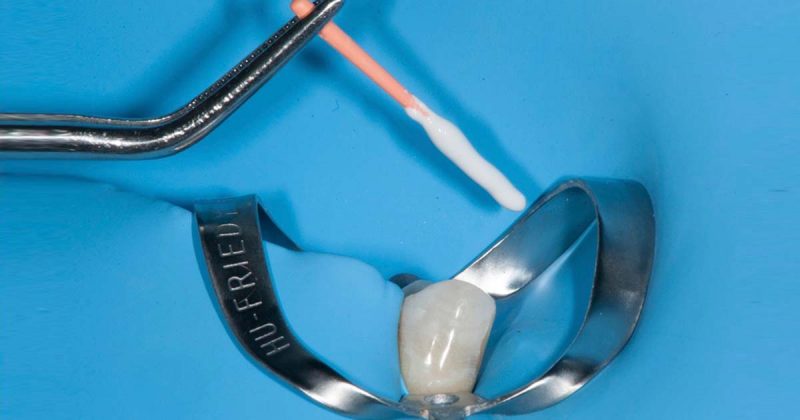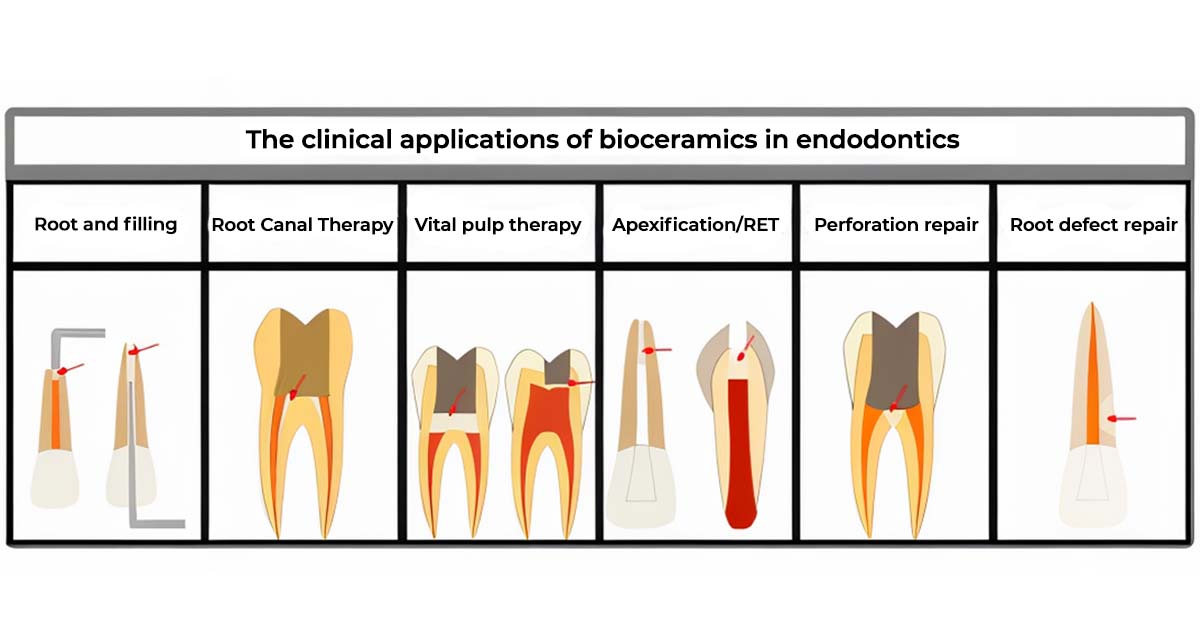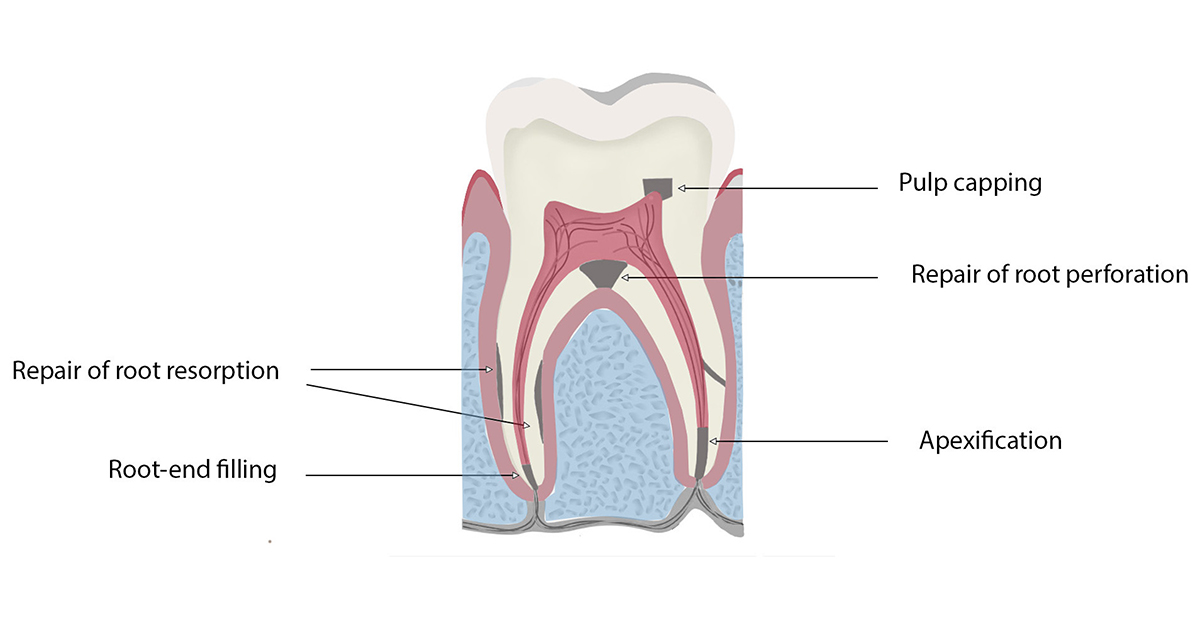Emerging Bioceramic Materials in Endodontics: Benefits, Limitations, and Clinical Applications

Bioceramic materials have emerged as a breakthrough in endodontics, offering biologically favorable properties that enhance healing and long-term treatment outcomes. Their excellent biocompatibility, antibacterial action, and ability to set in moist environments make them ideal for procedures involving the pulp and root canal system.
With ongoing advancements in material science, a variety of bioceramics are now available—each with specific characteristics suited to clinical needs. This blog explores some of the most widely used bioceramic materials in endodontics, focusing on their composition, benefits, limitations, and clinical applications.
What are Bioceramic Materials in Endodontics?
Bioceramics can be defined as materials with adequate biocompatibility that can be used to replace or regenerate damaged dental hard tissues. These materials interact with the dental pulp, the surrounding tooth, or the tissues of the root canal system. They are non-toxic, biocompatible, and non-shrinking in the biological environment of the tooth, which helps in the regeneration and repair of dental tissues.

Read Also: Effective Obturation Techniques for Successful Root Canal Treatments
Commonly used Bioceramic Materials in Endodontics:
Following are some commonly used and most effective bioceramic materials used in endodontics:
Mineral Trioxide Aggregate (MTA):
Mineral Trioxide Aggregate (MTA) was first described in modern dental scientific literature in 1993 and developed at Loma Linda University, California, USA. Torabinejad and Dean White subsequently obtained two US patents for this Portland cement-based endodontic material, which later came to be known as MTA, as three oxides are present in Portland cement—namely, calcia, silica, and alumina (CaO, SiO₂, and Al₂O₃) powder particles in their aggregate form.
Composition:
- Tricalcium silicate
- Dicalcium silicate
- Tricalcium aluminate
- Tetracalcium aluminoferrite (present only in Gray MTA)
- Bismuth Oxide (radiopacifier)
It may also contain traces of free crystalline silica, calcium oxides, free magnesium oxide, potassium, and sodium sulfate compounds. It is commercially available as Gray and White MTA.
Indications:
- Pulp Capping: MTA is capable of stimulating a higher quality and quantity of reparative dentin and also aids in superior long-term sealing ability.
- Pulpotomy: MTA pulpotomy forms a complete dentine bridge and maintains the vitality of the radicular pulp by limiting inflammation.
- Perforation Repair (lateral and furcation): It promotes bone healing and eliminates signs of inflammation.
- Root-end Filling: Studies have shown that teeth treated with MTA as a root-end filling material showed significantly better healing than those treated with orthograde GP filling.
- Resorption Repair: MTA was used as a root canal filling material for treating a double “Pink tooth” in research, and favorable results were found after 18 months. Hence, MTA may be a suitable material for the treatment of internal resorption.
- It can also be used as a sealer and as an obturating material (partial or complete).
Advantages:
- Excellent bacterial-tight seal
- Good pulp capping agent
- Can be used as a base for final restoration
- Microbial entombment and neutralization
- Strong capacity to generate a reparative calcific barrier
- Biocompatible
- Antibacterial (resists the penetration of bacteria better than calcium hydroxide)
- Promotes repair and maintains prolonged pulp vitality
- Ability to harden in the presence of blood and moisture (hygroscopic)
- Superior marginal adaptation and non-resorbable
- Used for direct pulp capping and pulpotomy procedures
- Biocompatible with pulpal and periodontal tissues

Disadvantages:
- Long setting time — approximately 6 hours
- Expensive
- Gray MTA can cause tooth discoloration
- Difficult handling
Top Recommendations: Waldent Endolife MTA (One Treatment Kit), Prime Dental Prime MTA Packable

Biodentine
Biodentine is a calcium silicate-based bioceramic material. It is specifically used for dentine repair and regeneration. Biodentine does not have the drawbacks of MTA or calcium hydroxide materials. It has the potential to manage deep carious cavities, whether the pulp is exposed or not.
Composition:
- Powder: Tricalcium silicate, dicalcium silicate, calcium carbonate, zirconium dioxide
- Liquid: Calcium chloride in aqueous solution with an admixture of polycarboxylate
Indications:
- Repair of perforations and resorption
- Apexification
- Root-end fillings
- Class II fillings as a temporary enamel substitute
- Large carious lesions as a permanent dentine substitute
- Direct pulp capping and pulpotomy
Advantages:
- Does not stain the tooth
- Excellent radiopacity
- No need for surface preparation or tedious bonding due to micro-mechanical anchorage
- Higher compressive strength than dentin; preserves pulp and promotes pulp healing
- Enhanced microleakage resistance due to the absence of shrinkage from its resin-free formula
- Shortest setting time — 10 minutes
- Excellent antibacterial properties, as the calcium hydroxide ions released from set Biodentine create a high alkaline pH, promoting an unfavorable environment for bacterial growth and aiding in the disinfection of adjacent hard and soft tissues
- High purity due to monomer-free composition
- Highly biocompatible and bioactive
Disadvantages:
- Slightly lower radiopacity compared to bismuth oxide-containing materials
- No salivary contamination should occur during its initial setting time of 10 minutes, which can be difficult to maintain
Top Recommendations: Septodont Biodentine (Single Pouch)

Bioaggregate:
Bioaggregate is a bioactive calcium silicate cement (CSC) that shows excellent capacity to stimulate hard tissue bridge formation and is considered a modified version of MTA.
Composition:
Nano particle-sized:
- Tricalcium silicate – component phase
- Tantalum oxide is added as a radiopacifier, and it is free of aluminum
- Calcium phosphate
- Silicon dioxide
Indications:
- Root perforation repair and root resorption repair
- Root-end filling
- Apexification
- Pulp capping
Advantages:
- It is a contamination-free and aluminum-free ceramic biomaterial
- Excellent handling characteristics after mixing with water
- Good radiopaque properties
- Promotes cementogenesis and forms a hermetic seal inside the root canal
- The absence of bismuth oxide prevents discoloration, making it more aesthetically friendly
Disadvantages:
- Radiopacity is slightly lower compared to bismuth oxide-containing materials
Calcium Enriched Mixture (CEM)
Calcium Enriched Mixture (CEM) is a bioactive calcium silicate cement introduced as a tooth-colored, water-based endodontic repair cement. It has similar applications to MTA but differs in chemical composition.
Composition
Powder:
- Calcium oxide (CaO)
- Sulfur trioxide (SO₃)
- Phosphorus pentoxide (P₂O₅)
- Silicon dioxide (SiO₂)
- Trace amounts of aluminum trioxide (Al₂O₃), sodium oxide (Na₂O), magnesium oxide (MgO), and chloride (Cl)
Liquid:
- Distilled water
Clinical Applications:
- Direct pulp capping
- Indirect pulp capping
- Pulpotomy
- Root-end filling material
- Furcation perforation repair
- Apexification
- Repair of root resorption
- Apexogenesis
Top Recommendations: Meta CeraSeal RC Sealer

Conclusion
Bioceramic materials have transformed the landscape of endodontic therapy by offering reliable, bioactive, and tissue-friendly solutions for complex clinical scenarios. With properties such as excellent biocompatibility, antibacterial action, and the ability to support hard tissue regeneration, materials like MTA, Biodentine, Bioaggregate, and CEM have become invaluable in treatments ranging from pulp capping to root-end surgeries.
As innovation in dental materials continues, the use of bioceramics is expected to expand further, enhancing long-term success rates in endodontics. Understanding their unique compositions, indications, and limitations enables clinicians to make informed decisions and deliver optimal patient care.
You can conveniently purchase these trusted bioceramic materials online at DentalKart, your one-stop destination for quality dental supplies.

No Comment